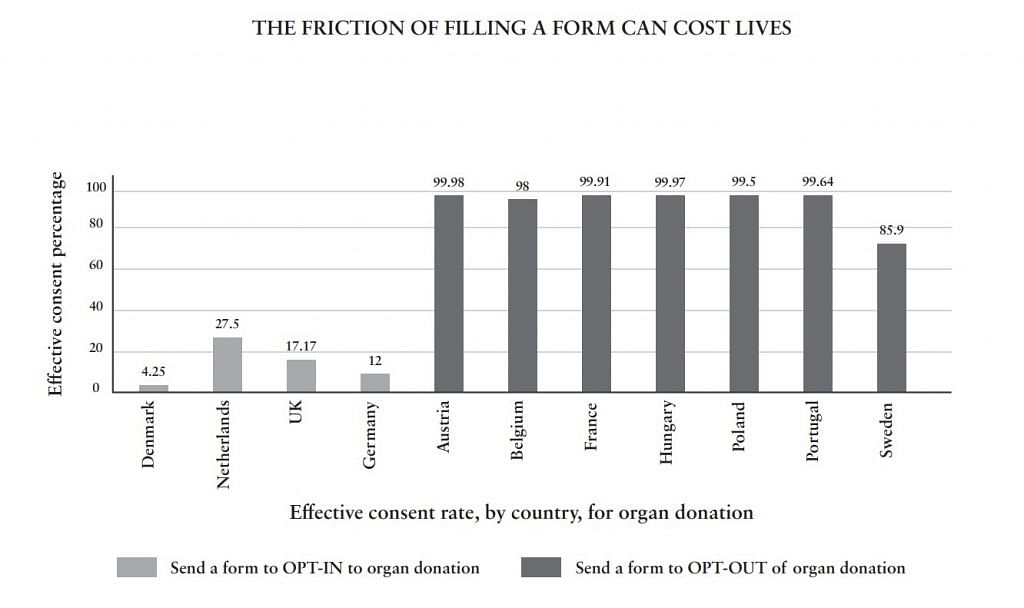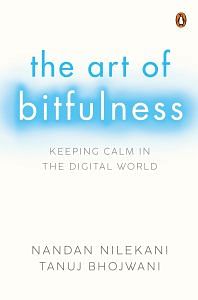In 2004, researchers Eric Johnson and Daniel Goldstein asked an intriguing question, ‘Do defaults change lives?’
Johnson and Goldstein were studying organ donation rates across Europe. They were investigating why some countries had a perpetually high rate of donations every year, whereas some had a perpetually low rate. This was very perplexing because organ donation rates in Sweden and Denmark, which were similar to each other geographically, demographically and culturally, stood at 85.9 per cent vs 4.25 per cent, respectively. The researchers ruled out all potential causes for the difference in rates, until only one remained.
Out of the eleven countries shown on this graph, all of those with high donation rates had one simple design decision. They had made organ donation the default and asked people to send a form to opt out. The countries with low organ donation rates asked people to opt in for it. Asking people to send in a form was friction enough to stop people from donating. Just making a simple change to the process could change donation rates. Or as Johnson and Goldstein put it, changing the default can save lives.
The lesson here is generalizable to more than just policy design. The design of how a choice is presented affects the choice itself. The consequences of the design are simple to understand when there is a form asking you to opt in or opt out. We make many more complex choices every day based on the information presented by our environment. If we are not mindful of our environment’s influence, we might be making the wrong decisions.
Also Read: How much is too much? There are 6 ways to know if you are addicted to binge-watching

In the purely analogue environment of the past, there was friction that would enforce some boundaries between different parts of life. Before smartphones, one was much less likely to get caught up reading a magazine article at their desk instead of working. To do that, one would have to intentionally bring a magazine to work or go out and find one. These tasks impose a significant cognitive effort and deliberate break from routine. We are likely to have paused and realized that we could read that article later. With smartphones, your friend may forward you a link to an article, and you end up reading it before you even realize you’re doing it.
We can change a lot about our digital behaviour by simply changing our information environment. The information environment means the entire ecosystem of devices, apps and data that make up our extended mind. From which device we use and where we use them, to the apps on them, can be selected and configured deliberately to assist us in focusing on our goal and steering us away from distractions.
You can try this yourself if you’re not convinced. Most of us carry our phones with us wherever we go, even when we’re merely moving from one room in our house to another. A straightforward way to keep your phone use to the minimum when at home is to simply leave it plugged in, away from your desk, in an area where there are no chairs, beds or other seating around. If we’re not comfortable while on our phones, our feet will eventually remind us to look up and go do something else.
The curse of technology available anytime, anywhere, is that we end up using it all the time, everywhere. Digital technologies that vie for our attention depend on our laziness. While they give us plenty of choices to turn distracting features off, or log out entirely, they put in a lot of friction to those choices. For example, one needs to go through a multi-step process to deactivate one’s Facebook account, including providing a reason why one is shutting down. But, simply logging in reactivates the account. They choose the defaults, so the defaults are, unsurprisingly, configured to get more of our time and attention.
Every time we drop in on our screens, we end up in front of an information environment, and its design is going to affect us whether we like it or not. By default, these environments make it easy to get distracted. We need to design our environment for maximizing flow and minimizing friction.
We believe that with mindful use of technology, we can make laziness our advantage instead of our weakness. Instead of trying to fight the tendency to be lazy, we align our objectives with it. We can design an environment such that focusing on the thing we want to do is the lazy option, and slacking off is the difficult one. We can learn how to not swim upstream by splitting our personalities.
Also Read: Deep breaths and counselling: How doctors are treating India’s ‘first Netflix addict’
Split accounts, not devices
There’s very little that our phones, tablets and laptops can’t do. We confuse that possibility for necessity.
Our devices are usually configured to have all the apps we could ever need in every context. By default, our social media is the same number of clicks away as our email on our phone, and both are available to us all the time. If we were to configure our technology mindfully, is this how it would look?
The lack of friction between these very different contexts means that at every moment, the only thing stopping us from getting distracted is our own willpower. It would be akin to trying to stay on a diet with a pocketful of our favourite candy.
As we learnt earlier, humans perform optimally when they are single-tasking with full engagement on a challenging problem. This state is also known as flow. Multitasking or switching contexts often carries a heavy cognitive penalty and breaks flow. Keeping our attention on a single task is hard if our environment is always presenting us with incoming, novel information.
One way around this problem would be to have different devices for different contexts. You could dedicate your laptop to doing work only and your smartphone to personal browsing. Or you could buy additional devices. However, buying additional devices soon becomes unwieldy, not to mention expensive. Until brain implants become a reality, we will still need to access the digital world through a physical device. For convenience, you want fewer devices to manage and charge, not more. This bottleneck is one that you can use to your advantage.
Nandan already divides his devices the way he wants to divide his time. He only does work on his PC. When he’s on the computer, he’s working. He checks his email for a long stretch twice a day, first thing in the morning and last thing at night. He batches emails that he has to send so as to not get lost in his inbox often. He consumes a curated selection of eight news subscriptions every day on his iPad and, occasionally, Twitter. When he wants to relax, he uses the same iPad for Netflix, Amazon Prime Video, and Disney+ Hotstar. His phone is for him to make calls and send texts. His phone is always on silent since this allows him to think. He has no email on his phone and no other apps that bombard him with information. The only game he plays is FreeCell (badly).
Admittedly, having multiple devices and the discipline to follow through on separating them is a tough ask. It may work for you, as it does for Nandan. Instead of having multiple devices, we can also have the same device configured for different modes by managing our identities. As users, we don’t pay particular attention to how we manage our identities. We tend to use the defaults suggested by our technology. We think in terms of usernames, passwords, accounts and profiles, but managing our identity can be much richer than that. Designed well, managing our identity can be extremely effective at helping us stay in control of our attention and manage our privacy.
On most laptops and smartphones, one can set up multiple user accounts. Each account created acts as a completely new and independent virtual space. This simple trick lets us effectively have many virtual devices, even when the physical device remains the same.
With multiple virtual devices, we can configure each identity thoughtfully for a purpose. We can give each account a ‘personality’. For example, if you are a writer, other than your usual account, you could have an account on your computer which has no other apps except the word processor you use. To do anything else, you’d first have to log out and then log in to another account.
Instead of exerting our willpower every single moment, we can invest time once in designing these accounts purposefully. On a daily basis, we simply need to choose which ‘personality’ we need to be in now. If we’ve configured these different contexts well, the opportunities for getting distracted reduce significantly.
Also Read: WFH, online classes, binge-watching during lockdown have started another ‘outbreak’
Splitting your personality is essentially a pre-commitment strategy. These are also known as ‘Ulysses pacts’ because of the use of this concept in Homer’s poem Odyssey. The hero Ulysses is sailing his way back home, but he must pass the Sirens. The Sirens were infamous for singing an irresistible song that led men to their deaths in the treacherous sea. Ulysses plugged the ears of his crew with wax. He instructed them to tie him to the mast and to stay the course no matter what he says in the future. Ulysses knew that his present self before being enthralled by the Sirens was a better decision-maker than his future self. He set up his environment accordingly.
In the digital world, you can lock yourself out of your social media accounts by logging out. Or simply give your phone to a loved one and ask them not to give it back to you till you finish some important task. Some pre-commitment strategies themselves are either high friction or not rigid enough to be useful. Splitting your personality lets you implement pre-commitments in a flexible manner.
People are often hesitant about pre-commitment strategies. They look at these pacts as inflexible, rigid constraints that limit freedom. A mindset shift is required to appreciate its power. These rigid boundaries do not keep us locked inside or restrict our freedom. Instead, these boundaries are meant to keep the constant din and noise outside so that we can be free to really focus.
Writers have often complained of procrastination. It might console you to know that even the best, most celebrated authors suffer the same problems as you do. The problem predates modern technology. Victor Hugo, the famous French novelist and poet, had signed a contract in 1829 to write a book he had titled The Hunchback of Notre Dame. Hugo spent the next twelve months entertaining guests, taking up side projects, and generally doing things other than writing the book that would eventually make him famous.
In September 1830, his publisher got furious with him and gave him an incredibly challenging six-month deadline to submit the novel by February of 1831. Hugo knew he was prone to being social, and this was his biggest temptation. He then made a Ulysses pact. He packed all his clothes and gave them to his attendant to keep away from his chambers. But for a shawl, Hugo was completely naked. Thus, with no option to go out or receive guests, Hugo worked on his novel non-stop.
He finished the 1,87,000-word novel two weeks early.

This excerpt from ‘The Art of Bitfulness: Keeping Sane in the Digital World’ by Nandan Nilekani and Tanuj Bhojwani has been published with permission from Penguin Random House.






